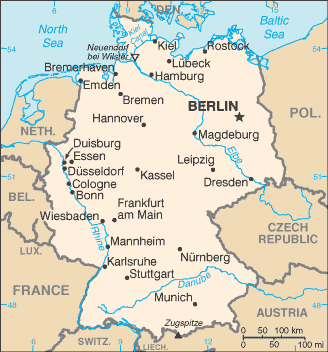Map:

Overview:
As Europe's largest economy and most populous nation, Germany remains a key member of the continent's economic, political, and defense organizations. European power struggles immersed Germany in two devastating World Wars in the first half of the 20th century and left the country occupied by the victorious Allied powers of the US, UK, France, and the Soviet Union in 1945. With the advent of the Cold War, two German states were formed in 1949: the western Federal Republic of Germany (FRG) and the eastern German Democratic Republic (GDR). The democratic FRG embedded itself in key Western economic and security organizations, the EC, which became the EU, and NATO, while the Communist GDR was on the front line of the Soviet-led Warsaw Pact. The decline of the USSR and the end of the Cold War allowed for German unification in 1990. Since then, Germany has expended considerable funds to bring Eastern productivity and wages up to Western standards. In January 1999, Germany and 10 other EU countries introduced a common European exchange currency, the euro.
The People:
Population: 82,431,390 (July 2005 est.)
Age structure:
0-14 years: 14.4% (male 6,078,885/female 5,766,065)
15-64 years: 66.7% (male 28,006,268/female 27,003,958)
65 years and over: 18.9% (male 6,359,776/female 9,216,438) (2005 est.)
Religions:
Protestant 34%, Roman Catholic 34%, Muslim 3.7%, unaffiliated or other 28.3%
Government Type:
federal republic
Leader(s) to pray for:
chief of state: President Horst KOEHLER (since 1 July 2004)
head of government: Chancellor Gerhard SCHROEDER (since 27 October 1998); Vice Chancellor Joschka FISCHER (since 17 October 1998)
Source: The World Factbook
View All Countries